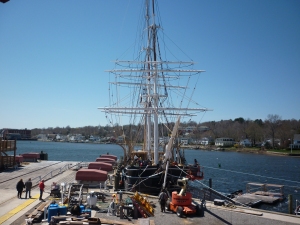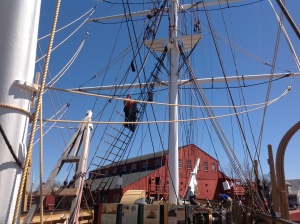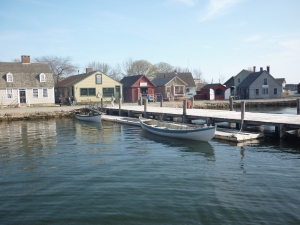 The Charles W Morgan alongside the shoplift dock. The shiplift was installed in 2007 and used to lift the whaleship, carefully cradled in blocks and braces, out of the water. A computer controls the lift, monitors and distributes loads and protects the vessel from damage. A horizontal track system moves the vessel ashore and a concrete platform under the rails collects all waste from the work on the ship. This protects the Mystic River’s water quality and marine habitat.
The Charles W Morgan alongside the shoplift dock. The shiplift was installed in 2007 and used to lift the whaleship, carefully cradled in blocks and braces, out of the water. A computer controls the lift, monitors and distributes loads and protects the vessel from damage. A horizontal track system moves the vessel ashore and a concrete platform under the rails collects all waste from the work on the ship. This protects the Mystic River’s water quality and marine habitat.Mystic Seaport, the Charles W Morgan and me
Last week in Connecticut, USA, I climbed aboard the Charles W Morgan for the first time. With the sailing date of 17 May 2014 fast approaching, riggers and shipwrights, painters and crew, electricians and carpenters, plumbers and deckhands were swarming about the ship in a frenzy of activity, patiently side stepping the curious and fascinated public who came to marvel and to question. I sat for a while at the captain and mates’ table beside the cabin which George Parkins Christian had occupied for 20 years, reflecting and writing, then exploring the crew cabins, the blubber room, the between decks areas, the fo’c’s’le.
 First Mate’s Cabin
First Mate’s CabinResponding to the 45mph winds outside, I felt the ship move heavily at the dock, almost as if sensing her imminent freedom. I heard the constant creaking of the hull and the sound of the wind singing through the rigging. I talked to Tim, a crew member painting thick tar on the dead eyes and rigging and Paul, a shipwright busy with woodwork below. Their excitement and passion for the project was infectious. Behind the roped off area, Paul showed me the gimballed and carved captain’s bed made for Lydia Landers when she joined her husband in 1863, the first of five captains’ wives who sailed on the Charles W Morgan. Quite comfy!
 Working on the rigging of the Charles W Morgan, in the background the H.B. du Pont Preservation Shipyard. This also includes a wonderful exhibition on the restoration process.
Working on the rigging of the Charles W Morgan, in the background the H.B. du Pont Preservation Shipyard. This also includes a wonderful exhibition on the restoration process. Preparing the rigging
Preparing the riggingWhy was I in Mystic Seaport? I am lucky enough to be one of two people from the UK chosen to be part of the group of 79 38th Voyagers. Each of us has a project – art, writing, education, film, scientific or historic research, textiles, photography, literature, poetry, music, journalism, oceanography, conservation – and the 38th Voyage will allow us the opportunity to experience, explore and create, producing a lasting legacy from the project and for the museum at Mystic Seaport.
This is the first of the blog posts tracking progress of what I call my Pacific Islands project. It is also my Charles W Morgan project, developing in parallel from the moment I was accepted as a voyager on the 1841 whaleship’s historic 38th voyage from Mystic Seaport to New Bedford and beyond between May and August 2014. I will be sleeping on board in the fo’c’s’le the night before we sail and travelling, hopefully sailing, from Vineyard Haven to New Bedford in late June.
 The hull showing work progressing above the waterline, starboard side
The hull showing work progressing above the waterline, starboard sideTo give you something of the flavour of why this is so exciting and important for me, let me say first of all that this is a ship my great-great grandparents knew and saw, possibly even went aboard, as it lay at anchor off their remote island home in the Kermadecs. At the very least they knew crew members, especially George Parkins Christian who had arrived some years earlier at Sunday Island on another New Bedford whaler, the California, before he signed on as mate on the Charles W Morgan in the mid-1890s. My great grandmother Bessie also knew the ship so this wonderful survivor is a direct link between them and the past and me and the present. Over the next few months I will be concentrating my research on the whale ships which visited Sunday Island and reading their logs where they survive, and focussing on members of the crew that were mentioned by name in my great-grandmother’s recorded memories. I will also be looking at the attitudes of my ancestors to whales and whaling and the natural world and the links between the whaling ships and Sunday, Pitcairn and Norfolk Islands. 
 Mystic Seaport – The Museum of America and the Sea
Mystic Seaport – The Museum of America and the SeaSecondly as a passionate heritage professional I will be exploring how Mystic Seaport has shaped the restoration and research project starting with a daring vision of what might be possible – sailing the last surviving wooden whaling ship once more – and engaging the public in realizing that vision.
Next – climbing the rigging and rowing the whaleboat!





